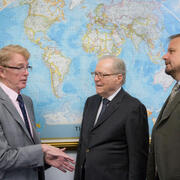
Remembering Dale W. Jorgenson and his many contributions to research on energy, environment, and China's economy
By Harvard-China Project on Energy, Economy and Environment
Dale W. Jorgenson, one of the founding faculty leaders of what is now the Harvard-China Project on Energy, Economy, and Environment, passed away June 8, 2022, aged 89. As a Harvard Professor of Economics and University Professor, he continued to be one of the China Project’s most active faculty participants throughout its history. Two weeks before he died, he hosted a welcome dinner for the Project’s two newest visiting Ph.D. students, from Tsinghua University. He died of respiratory complications and is survived by his wife Linda, two children, and three grandchildren.
Jorgenson was a pioneer in multiple areas of economics. These included information technology and economic growth, tax policy and investment behavior, applied econometrics and, most relevant here, energy economics and analysis of environmental policy.
As the world’s foremost scholar of productivity measurement, he had written about energy productivity and econometric analysis of energy inputs since the 1970s. His 1974 model of U.S. economic growth was one of the earliest inter-industry models with an econometric treatment of energy inputs. He led a team of collaborators to develop the model and use it for analyzing energy shocks, environmental policies, tax reforms, and carbon pricing. A book distilling this research, Double Dividend: Environmental Taxes and Fiscal Reform in the United States, with three co-authors including Mun Ho, his long-time associate and co-leader of the China Project’s economics research. Jorgenson employed these tools in statutory assessments of environmental policies for the U.S. Environmental Protection Agency, notably of the Clean Air Act.
Jorgenson’s research on productivity and economic growth spanned the globe. As Michael McElroy started development in 1993 of a multi-disciplinary research program on China under Harvard’s University Committee on the Environment, Jorgenson and Dwight Perkins initiated an economics component by constructing a simple model of China’s economic growth and energy demand. This was published in the China Project’s first book, Energizing China: Reconciling Environmental Protection and Economic Growth, and set the basis for Jorgenson’s decades of partnership with McElroy leading the Project’s economics research. He began travelling to China to work with collaborators and attend conferences and workshops, including a number organized by the Project. He supervised the Harvard Ph.D. dissertation of Jing Cao, who as a Tsinghua University professor continued to collaborate closely with Jorgenson and today remains one of the Project’s lead economists.
Jorgenson later advised and contributed to broadly interdisciplinary studies led by Chris Nielsen and Ho that integrated atmospheric sciences, engineering, environmental health, and economics, published in the 2007 volume, Clearing the Air: The Health and Economic Damages of Air Pollution in China, and the more advanced 2013 sequel, Clearer Skies Over China: Reconciling Air Quality, Climate, and Economic Goals. In these book-length assessments bridging schools of Harvard and those of Chinese universities, Jorgenson, Ho, and later Cao used results from modeling air pollution emissions and concentrations, human and crop exposures, and health and agricultural impacts to allocate pollution damages to different sectors and fuels. They then applied an energy-environmental-economic model of China to simulate the impact of policies, such as carbon taxes, on air pollution damages and economic growth.
More recently, Jorgenson guided a new cohort of students from China to use household survey data to study energy consumption behavior and to use firm data to study their energy-output relationships. His most recent paper is “Urban Household Consumption in China: Price, Income, and Demographic Effects,” published in 2020 when he was aged 87. Another notable paper in his last years is “China’s Emissions Trading System and an ETS-Carbon Tax Hybrid,” published in 2019.
Most researchers of the China Project, in all fields, knew Jorgenson from his regular presence in the Project’s Pierce Hall conference room, mainly to meet with research fellows but also to strategize with Ho, Nielsen, and McElroy. Some knew him better than others, but the entire China Project community mourns the sudden loss. He has left a void that will be hard to fill, not just in the work of the China Project but also in its atmosphere of active and supportive mentorship from its most distinguished senior leaders. Yet he has also left a worldwide network of students and collaborators who have learned much from him and will surely extend the work he pioneered, as well as the spirit of generous shared inquiry with which he pursued it.